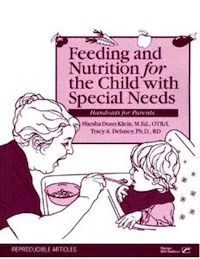
Therapy Tips
Clinicians always are in need of reference materials to supplement their therapy and answer questions from parents. This 600-page reference binder was written in response to requests from clinicians for a resource of handouts for parents. Authors Marsha Dunn Klein, M. Ed., OTR/I, and Tracy A. Delaney, Ph.D., RD, felt that combining information on the "what to eat" with the "how to eat" would provide a novel integration of pediatric therapies and nutrition.
 For most babies, transitioning from liquid to pureed foods is an easy task. However, some children with medical, physical or touch-sensitivity issues can find it difficult to adjust to the process and texture of eating purees. Some children have a hard time with tongue control due to muscles that are too tight or weak. Still others don’t like changes in texture and can’t properly handle the feeling of purees in their mouths.
For most babies, transitioning from liquid to pureed foods is an easy task. However, some children with medical, physical or touch-sensitivity issues can find it difficult to adjust to the process and texture of eating purees. Some children have a hard time with tongue control due to muscles that are too tight or weak. Still others don’t like changes in texture and can’t properly handle the feeling of purees in their mouths.
Solid foods are a big step for a baby. Find out when and how to make the transition from breast milk or formula to solid foods.
10 Tips to Help a Child with Special Needs Transition from Liquid to Solid Foods
Babies typically transition from liquid to solid foods by the ages of 4 to 6 months. For most, this is an easy transition. However, children with different medical, physical or sensory needs may have difficulty adjusting to the texture of purees and solid foods and the process of eating them. If your child resists purees or consistently coughs or gags during mealtime, here are 10 tips to help make the process easier for the both of you.1. Proper positioning
Making sure your child is sitting in a supported upright position with good foot support is an important first step. Poor positioning can make feeding more difficult. If your child is leaning in his highchair to one side or the other, try rolling up baby blankets or towels and place next to your child to provide added support. Adjust the foot rest so his knees are at a 90 degree angle.2. Offer liquid on a spoon
The same idea of familiarity applies when introducing your child to the spoon. To help your child get used to this new method of feeding, offer formula or breast milk from the spoon. As your child gets used to the spoon, gradually change to thicker textures.3. Mix a new taste with a familiar taste
Your child may respond to a new taste better if it is accompanied by a familiar taste. Try mixing equal parts formula or breast milk with rice or oat cereal. The familiar taste may help your child feel more comfortable exploring solid food.4. Introduce a new taste from a familiar source
Your child is used to feeding from a nipple, so it may be overwhelming for him to try a new taste, texture and spoon all at once. To assist this transition, you can try dipping the nipple or pacifier in a small amount of puree to give your child a taste.5. Give your child opportunities to chew
Your child may need to get used to the concept of chewing before the transition to solid foods. Help your child practice chewing by giving him teething toys or hard munchables like teething biscuits. It’s important to remember that you should never leave your baby alone with objects to put in his mouth to prevent choking.6. Practice with meltable solid food
A meltable solid has a “hard” texture, but quickly dissolves when placed in the mouth, making it easy for a baby to chew and swallow. Meltable solid food may help your baby get used to a new texture and practice early chewing skills. Examples of this texture are toddler “puffs” (Gerber Graduates®), veggie snack stix or graham crackers.7. Invite your child to play with new textures
Try putting some puree on the high chair tray and encourage your child to touch it and taste it from his fingers. You can also dip your child’s favorite washable toy in puree and allow your child to mouth the toy while introducing the new taste.8. Give your child the choice between two purees
Your child may feel intimidated when there is loss of control, causing him to have a negative reaction to new foods. Given a choice, your child may naturally decide when it is time to try something new. Offer a choice between a familiar food and a new food. Allow your child time to experience new foods with his eyes by just having them close to him, but not forcing him to eat or try them.9. Introduce table food of similar color, texture or shape
If your child has successfully transitioned to pureed food, try introducing table food with a similar flavor or texture. If your child likes pureed carrots, offer mashed carrots or a mixture of mashed carrots and puree. A stick of orange cheese could follow a meltable cheese puff.10. Give your child more time
A child with special needs may simply need more time to adjust to a new process, especially if the child is delayed in other areas of development. Here are some signs that indicate your baby is ready to transition to solid food:- Your baby can hold his head in a steady, upright position.
- Your baby can sit up with support.
- Your baby is mouthing his toys and hands.
Helpful Resources
 Feeding and Nutrition for the Child with Special Needs
Feeding and Nutrition for the Child with Special Needs
Clinicians always are in need of reference materials to supplement their therapy and answer questions from parents. This 600-page reference binder was written in response to requests from clinicians for a resource of handouts for parents. Authors Marsha Dunn Klein, M. Ed., OTR/I, and Tracy A. Delaney, Ph.D., RD, felt that combining information on the "what to eat" with the "how to eat" would provide a novel integration of pediatric therapies and nutrition.
Transitioning Your Child from Liquid to Solid Foods
 For most babies, transitioning from liquid to pureed foods is an easy task. However, some children with medical, physical or touch-sensitivity issues can find it difficult to adjust to the process and texture of eating purees. Some children have a hard time with tongue control due to muscles that are too tight or weak. Still others don’t like changes in texture and can’t properly handle the feeling of purees in their mouths.
For most babies, transitioning from liquid to pureed foods is an easy task. However, some children with medical, physical or touch-sensitivity issues can find it difficult to adjust to the process and texture of eating purees. Some children have a hard time with tongue control due to muscles that are too tight or weak. Still others don’t like changes in texture and can’t properly handle the feeling of purees in their mouths.



